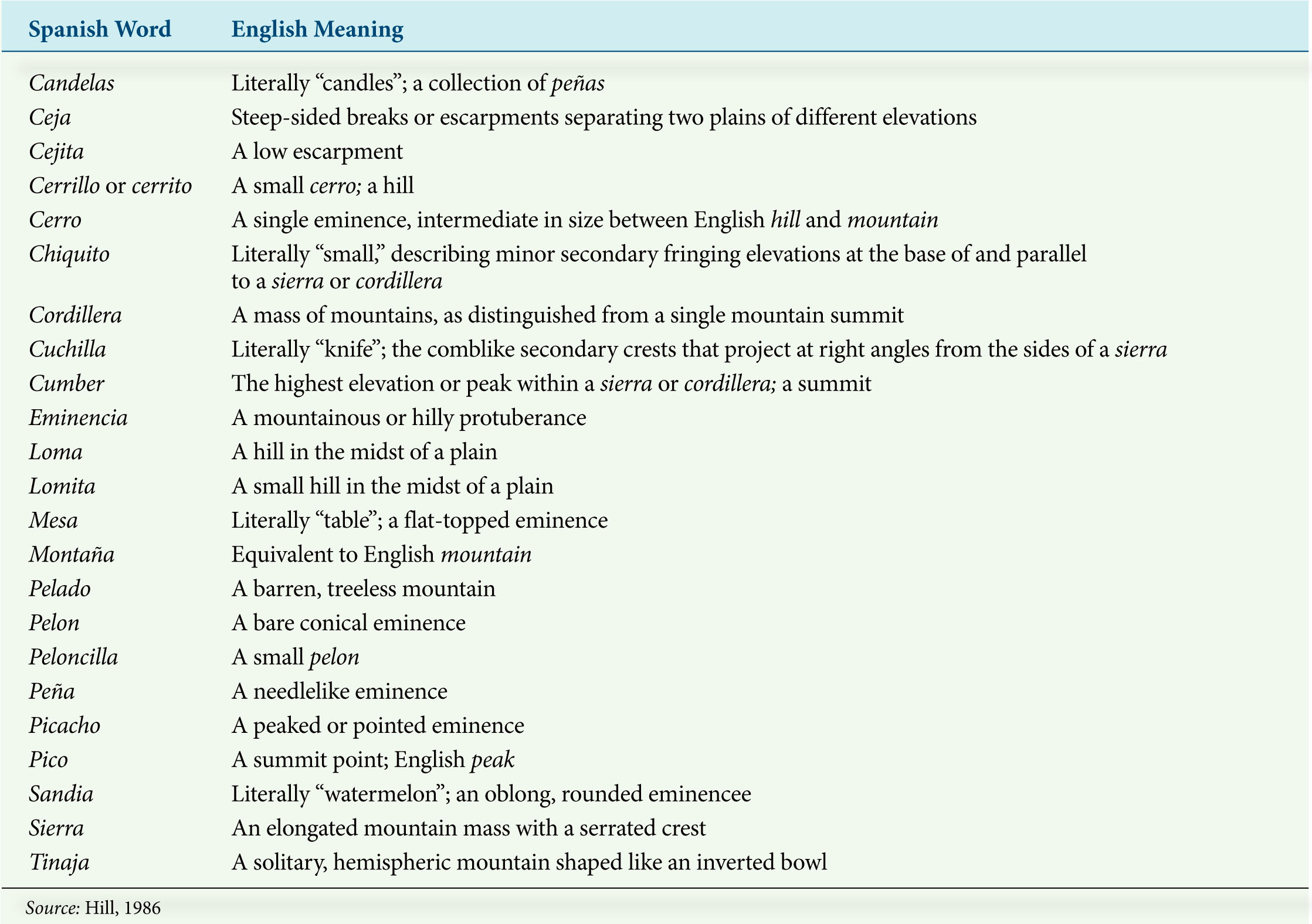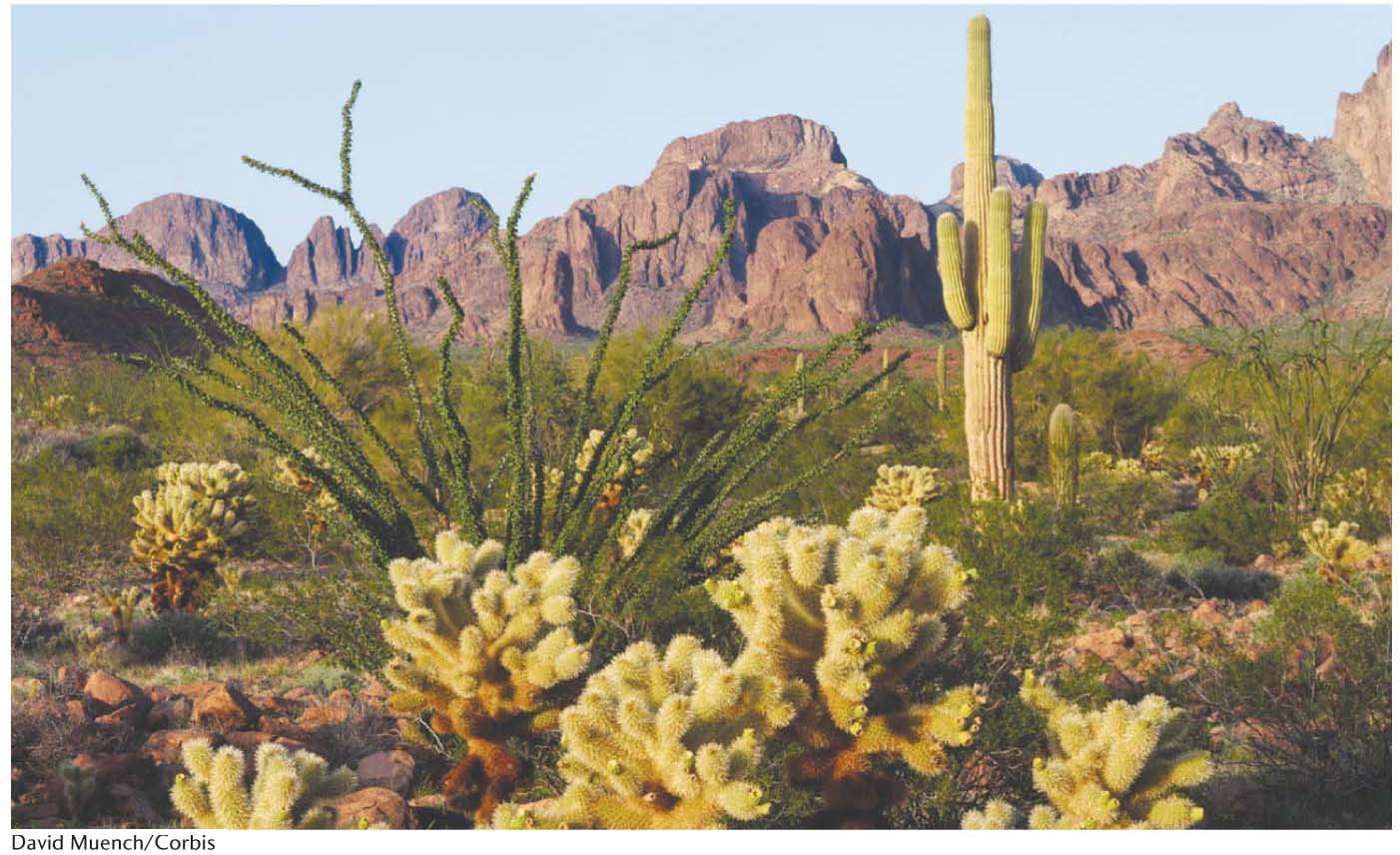NATURE-CULTURE
4.4
LEARNING OBJECTIVE
Explain the relationships between language and the physical environment.
Language interacts with the environment in two basic ways. First, the specific physical habitats in which languages evolve help shape their vocabularies. Second, the environment can guide the migrations of linguistic groups or provide refuges for languages in retreat. The following section, from the viewpoint of possibilism—the notion that the physical environment shapes, but does not fully determine, cultural phenomena—illustrates how the physical environment influences vocabulary and the distribution of language.
159
HABITAT AND VOCABULARY
Humankind’s relationship to the land played a strong role in the emergence of linguistic differences, even at the level of vocabulary. For example, the Spanish language—which originated in Castile, Spain, a dry and relatively barren land rimmed by hills and high mountains—is especially rich in words describing rough terrain, allowing speakers of this tongue to distinguish even subtle differences in the shape and configuration of mountains, as Table 4.3 reveals. Similarly, Scottish Gaelic possesses a rich vocabulary to describe types of topography; this terrain-focused vocabulary is a common attribute of all the Celtic languages spoken by hill peoples. In the Romanian tongue, also born of a rugged landscape, words relating to mountainous features emphasize use of that terrain for livestock herding. English, by contrast, which developed in the temperate wet coastal plains of northern Europe, is relatively deficient in words describing mountainous terrain (Figure 4.15). However, English abounds with words describing flowing streams and wetlands: typical physical features found in northern Europe. This vocabulary transferred well to the temperate East Coast of the United States. In the rural American South alone, one finds river, creek, branch, fork, prong, run, bayou, and slough. This vocabulary indicates that the area is a well-watered land with a dense network of streams.


160
Clearly, then, language serves an adaptive strategy. Vocabularies are highly developed for those features of the environment that involve livelihood. Without such detailed vocabularies, it would be difficult to communicate sophisticated information relevant to the community’s livelihood, which in most places is closely bound to the physical landscape.
THE HABITAT HELPS SHAPE LANGUAGE AREAS
Environmental barriers and natural routes have often guided linguistic groups onto certain paths. The wide distribution of the Austronesian language group, for instance, was profoundly affected by prevailing winds and water currents in the Pacific and Indian oceans. The Himalayas and the barren Deccan Plateau deflected migrating Indo-Europeans entering the Indian subcontinent into the rich Ganges-Indus River plain. The northern and southern dialect boundaries in the United States are loosely limited by the Mississippi River.
Because such physical barriers as rivers and mountain ridges can discourage groups from migrating from one area to another, they often serve as linguistic borders as well. In parts of the Alps, speakers of German and Italian live on opposite sides of a major mountain ridge. Portions of the mountain rim along the northern edge of the Fertile Crescent in the Middle East form the border between Semitic and Indo-European tongues. Linguistic borders that follow such physical features generally tend to be stable, and they often endure for thousands of years. By contrast, language borders that cross plains and major routes of communication are often unstable.
THE HABITAT PROVIDES REFUGE
The environment also influences language insofar as inhospitable areas provide protection and isolation. Such areas often provide minority linguistic groups refuge from aggressive neighbors and are, accordingly, referred to as linguistic refuge areas. Rugged hilly and mountainous areas, excessively cold or dry climates, dense forests, remote islands, and extensive marshes and swamps can all offer protection to minority language groups. For one thing, unpleasant environments rarely attract conquerors. Also, mountains tend to isolate the inhabitants of one valley from those in adjacent ones, discouraging contact that might lead to linguistic diffusion.
linguistic refuge area
An area protected by isolation or inhospitable environmental conditions in which a language or dialect has survived.
Examples of these linguistic refuge areas are numerous. The rugged Caucasus Mountains and nearby ranges in central Eurasia are populated by a large variety of peoples and languages (Figure 4.16). In the Rocky Mountains of northern New Mexico, an archaic form of Spanish survives, largely as a result of isolation that ended only in the early 1900s. Similarly, the Alps, the Himalayas, and the highlands of Mexico form fine-grained linguistic mosaics, thanks to the mountains that provide both isolation and protection for multitudinous languages. The Dhofar, a mountain tribe in Oman, preserves Hamitic speech, a language family otherwise vanished from all of Asia. Bitterly cold tundra climates of the far north have sheltered Uralic and Inuktitut speakers, and a desert has shielded Khoisan speakers from Bantu invaders. In short, rugged, hostile, or isolated environments protect linguistic groups that might otherwise be eclipsed by more dominant languages.

161
162
Still, environmental isolation is no longer the vital linguistic force it once was. Fewer and fewer places are so isolated that they remain little touched by outside influences. Today, inhospitable lands may offer linguistic refuge, but it is no longer certain that they will in the future. Even an island situated in the middle of the vast Pacific Ocean does not offer reliable refuge in an age of airplanes, satellite-transmitted communications, and global tourism. Similarly, marshes and forests provide refuge only if they are not drained and cleared by those who wish to use the land more intensively. The nearly 10,000 Gullah-speaking descendants of African slaves have long nurtured their distinctive African-influenced culture and language, in part because they reside on the Sea Islands of South Carolina, Georgia, and North Florida. Today, the development of these islands for tourism and housing for wealthy nonlocals, as well as the out-migration of Gullah youth in search of better economic opportunities, threatens the survival of the Gullah culture and language. The reality of the world is no longer isolation, but contact.